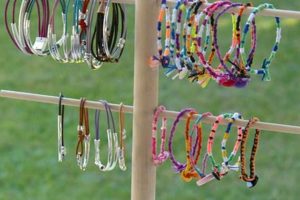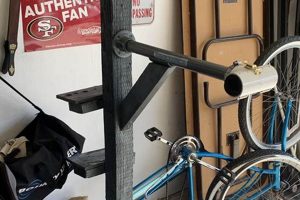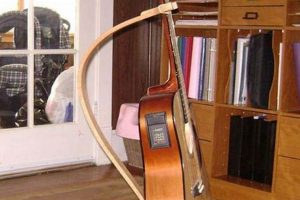A self-assembled structure designed to support balloons, often used for decorations at events or celebrations, represents a cost-effective and customizable alternative to commercially produced display systems. These structures can be constructed from readily available materials such as PVC pipes, wooden dowels, or even cardboard, allowing for variations in height, width, and overall aesthetic appeal based on the intended application. As an example, a framework made from PVC plumbing components provides a stable and reusable base for creating a balloon arch.
The advantages of creating a supportive balloon display system oneself include substantial cost savings, particularly when decorating for large events. Furthermore, the process allows for complete personalization, enabling adjustments to size, shape, and color scheme to perfectly complement the event’s theme. Historically, simple balloon supports were often improvised using chairs or other existing furniture. The formalized creation of these independent supporting structures represents a progression toward more visually appealing and stable balloon arrangements.
The following article sections will detail specific construction techniques, material considerations, and design variations suitable for crafting robust and visually impressive balloon display solutions. Topics addressed will include securing balloons to the framework, designing stable bases, and incorporating lighting or other decorative elements to enhance the overall presentation.
Construction Recommendations
The following guidelines are intended to optimize the creation of stable and visually appealing balloon display structures.
Tip 1: Base Stability. Prioritize a wide and weighted base to prevent tipping. A circular wooden base or a sand-filled container provides enhanced stability, particularly for taller arrangements.
Tip 2: Frame Material Selection. PVC piping is a durable and lightweight option. However, ensure the pipe diameter is sufficient to support the weight of the balloons without bending or breaking.
Tip 3: Secure Balloon Attachment. Utilize fishing line or strong floral wire to firmly attach balloons to the structure. Knot the line securely and avoid excessive slack, which can lead to uneven balloon distribution.
Tip 4: Gradual Construction. Assemble the framework in stages. Build the base and main support structure before adding balloon clusters. This facilitates easier handling and prevents accidental damage to inflated balloons.
Tip 5: Consider Wind Resistance. For outdoor applications, anticipate wind conditions. Secure the base to the ground with stakes or additional weights, and opt for smaller, tightly packed balloon clusters to minimize wind resistance.
Tip 6: Incorporate Reinforcements. For larger or more complex designs, incorporate internal supports or cross-bracing to enhance the overall structural integrity. This is especially crucial for arches and large columns.
Tip 7: Pre-Assembly Testing. Conduct a trial run of the assembly process before the event. This allows for identification of potential weaknesses or design flaws and provides an opportunity for corrective measures.
Adhering to these construction recommendations will result in a more durable, visually appealing, and ultimately successful balloon display structure.
The subsequent sections will explore specific design variations and advanced construction techniques to further elevate the quality and impact of self-made balloon displays.
1. Stability
Stability is a paramount consideration in the design and construction of self-assembled balloon support structures. Without adequate stability, the structure risks tipping, potentially damaging the balloon arrangement and posing a safety hazard. Proper attention to base design, weight distribution, and material selection is essential to mitigate these risks.
- Base Weight and Distribution
The weight and distribution of the base directly influence the structure’s resistance to tipping forces. A heavier base provides greater inertia, requiring more force to displace it. Concentrating weight low to the ground lowers the center of gravity, enhancing stability. For example, a wide wooden base filled with sand or concrete will provide more stability than a lightweight plastic base.
- Center of Gravity
Lowering the center of gravity is crucial for maintaining equilibrium. The higher the center of gravity, the easier it is for the structure to topple. Distributing the weight of the balloons evenly across the structure, and ensuring the base is significantly heavier than the upper portion, helps lower the center of gravity. An uneven distribution of balloons, conversely, raises the center of gravity, increasing the risk of instability.
- Material Rigidity
The rigidity of the materials used in the support structure contributes to its overall stability. Flexible materials like thin plastic pipes may bend or buckle under the weight of the balloons, compromising the structure’s integrity. Stiffer materials, such as PVC pipes with adequate wall thickness or metal rods, provide greater resistance to bending and deflection, resulting in a more stable framework.
- Environmental Factors
External environmental factors, such as wind, can significantly impact the stability of outdoor balloon structures. Even a mild breeze can exert considerable force on a large balloon arrangement, potentially causing it to topple. Securing the base to the ground with stakes or additional weights can mitigate the effects of wind. Choosing a design that minimizes the surface area exposed to the wind can also improve stability in outdoor settings.
In summation, the stability of self-made balloon supports is not merely an aesthetic concern but a fundamental aspect of safety and structural integrity. Addressing the factors of base weight, center of gravity, material rigidity, and environmental conditions contributes significantly to a durable and reliable structure. Failure to prioritize these aspects may result in structural failure and potential harm.
2. Materials
Material selection is a foundational element in the successful creation and functionality of any self-assembled balloon support. The physical properties of chosen materials directly influence the structure’s stability, durability, and aesthetic appeal. Inadequate material choices can compromise the structural integrity, leading to collapse and failure of the balloon display. For example, using thin-walled PVC piping for a large balloon arch may result in bending or breakage under the weight of the balloons. Conversely, appropriate material selection ensures longevity and a professional presentation.
Consider the common application of PVC piping: its lightweight nature and relative strength make it a versatile choice. However, the diameter and wall thickness of the pipe must be matched to the size and weight of the intended balloon arrangement. Wood offers a more robust option, especially for base construction, where weight and stability are paramount. Cardboard, while inexpensive and readily available, is best suited for smaller, less demanding applications. The connecting hardware, such as joints and fasteners, must also be compatible with the chosen materials to create a secure and lasting bond. The cost of materials also serves as a determining element.
In conclusion, the selection of appropriate materials is integral to the construction of a reliable and visually pleasing self-made balloon support. Balancing cost-effectiveness with structural requirements ensures that the final product meets its intended purpose. Recognizing the properties and limitations of different materials allows for informed decision-making, leading to a successful and enduring display. Challenges remain in selecting environmentally friendly materials.
3. Design
Design, in the context of self-assembled balloon support structures, is a critical determinant of both functionality and aesthetic appeal. A well-conceived design addresses structural stability, visual harmony, and ease of assembly, contributing directly to the overall success of the project. Conversely, a poorly planned design can result in instability, visual imbalances, and construction difficulties.
- Structural Integrity Planning
The initial design phase must prioritize the structural integrity of the support framework. This includes calculations related to load-bearing capacity, wind resistance, and material stress. A design lacking sufficient structural considerations may be prone to collapse or instability. For instance, a tall, narrow column design requires a wider, heavier base to prevent tipping, especially in outdoor settings.
- Aesthetic Composition
Beyond structural concerns, the design dictates the visual impact of the balloon display. Considerations such as color coordination, balloon arrangement, and overall symmetry contribute to the aesthetic appeal. A well-designed display harmonizes with the event’s theme and enhances the overall ambiance. Conversely, a haphazard or poorly color-coordinated design can detract from the event’s visual appeal.
- Assembly Efficiency
A design that incorporates modular components and straightforward connection methods streamlines the assembly process. Clear instructions and intuitive assembly procedures minimize errors and reduce construction time. A complex or overly intricate design, on the other hand, can lead to frustration and increased assembly time, potentially impacting the timeliness of the event setup.
- Adaptability and Customization
A flexible design allows for adaptability to various event themes and customization options. This may include adjustable height settings, interchangeable decorative elements, or the ability to reconfigure the structure into different shapes. A rigid or inflexible design limits the options for personalization, restricting its suitability for a wide range of events.
The interplay between these design elements directly impacts the final outcome of the self-made balloon support. Prioritizing structural integrity, aesthetic composition, assembly efficiency, and adaptability ensures a visually appealing, structurally sound, and easily constructible display. Neglecting any of these aspects compromises the overall effectiveness and impact of the project.
4. Assembly
The assembly phase represents the culmination of planning and material preparation in the creation of self-assembled balloon supports. Competent execution of the assembly process directly determines the structural integrity, visual presentation, and overall success of the project. A poorly executed assembly can compromise even the most meticulously designed structure, leading to instability, misalignment, or complete failure. For example, inadequate joining of PVC pipe segments can result in a weakened frame unable to support the weight of the balloons. This phase necessitates precision, adherence to design specifications, and attention to detail.
The sequence of steps in assembly dictates the efficient progression of the project. Typically, the base construction precedes the erection of vertical supports and subsequent attachment of balloon clusters. Deviations from a logical assembly sequence can lead to logistical challenges and increased risk of damage to partially completed components. For instance, attempting to attach balloons to a structure before securing the base can render the entire assembly unstable and prone to toppling. Utilizing pre-prepared components and employing appropriate fastening techniques further enhance the efficiency and stability of the final product. Clear instructions and readily available tools contribute to a smooth assembly experience.
In summary, the assembly phase is not merely a procedural step, but an essential component in realizing the intended functionality and aesthetic value of self-made balloon supports. Proper execution necessitates careful planning, adherence to design specifications, and a systematic approach. Attention to detail and the utilization of appropriate tools and techniques contribute to a structurally sound and visually appealing final product, thereby ensuring the success of the decorative endeavor.
5. Durability
Durability, in the context of self-assembled balloon support structures, refers to the ability of the framework to withstand prolonged use, environmental stressors, and the weight of the balloon arrangement without experiencing significant degradation or failure. This characteristic is paramount for reusable structures intended for multiple events, as well as for outdoor displays subjected to wind, sunlight, and temperature fluctuations. The durability of a balloon support influences its longevity, cost-effectiveness, and overall reliability.
- Material Resistance to Environmental Factors
The inherent resistance of chosen materials to environmental elements such as moisture, ultraviolet radiation, and temperature variations directly impacts the durability of the assembled structure. Materials prone to degradation under prolonged exposure to these elements will exhibit reduced structural integrity and shortened lifespan. For example, untreated wood exposed to moisture may rot and weaken, while certain plastics may become brittle and crack under prolonged UV exposure. Selection of weather-resistant materials is crucial for outdoor applications.
- Joint Strength and Connection Integrity
The strength and integrity of the joints and connections within the support structure determine its ability to withstand stress and prevent separation under load. Weak or improperly secured joints represent points of potential failure, particularly under dynamic stress imposed by wind or movement. Employing robust fastening methods, such as screws, bolts, or adhesives designed for the selected materials, is essential to ensure durable and reliable connections.
- Structural Design and Load Distribution
The structural design of the support, including the distribution of load-bearing elements, influences its overall durability. A design that concentrates stress on specific points or lacks adequate reinforcement may be prone to premature failure. Distributing the weight of the balloon arrangement evenly across the framework and incorporating reinforcing elements, such as cross-bracing or gussets, can enhance the structure’s ability to withstand load and resist deformation over time.
- Maintenance and Storage Practices
Proper maintenance and storage practices contribute significantly to the extended durability of self-assembled balloon supports. Regular cleaning to remove dirt and debris, protective coatings to prevent environmental degradation, and proper storage in a dry and sheltered environment can minimize wear and tear. Neglecting these practices can accelerate material degradation and shorten the lifespan of the structure, even when constructed from durable materials.
These facets, when carefully considered, contribute significantly to the overall durability of a balloon support. A durable structure translates to fewer replacements, lower long-term costs, and a consistently reliable display for various events. Addressing material selection, joint integrity, design considerations, and maintenance protocols is critical to maximizing the lifespan and utility of the support.
6. Customization
The capacity for customization is a defining characteristic of self-constructed balloon support structures, and a primary driver for choosing this approach over commercially produced alternatives. The impetus for creating a balloon arrangement often stems from a specific event theme, color scheme, or spatial requirement. Pre-fabricated stands typically offer limited options regarding size, shape, and decorative elements, rendering them unsuitable for applications requiring a high degree of personalization. The opportunity to tailor every aspect of the supporting structure to meet precise specifications represents a significant advantage.
Customization manifests in several key areas: dimensional adjustments to accommodate varying ceiling heights or table sizes; material selection to align with budgetary constraints or desired aesthetic qualities; and decorative enhancements, such as integrated lighting or themed ornamentation. For example, a wedding celebration may necessitate a tall, elegant archway constructed from metallic-painted PVC pipes, adorned with floral accents and illuminated by concealed LED strips. Conversely, a child’s birthday party might benefit from a smaller, brightly colored stand crafted from lightweight cardboard, incorporating cartoon character cutouts and easily disassembled for storage. The ability to adapt the structure to the unique demands of each event increases its versatility and value.
The inherent flexibility afforded by self-construction methods enables individuals to translate creative visions into tangible realities. The challenge lies in balancing the desire for personalization with the practical constraints of material availability, construction skills, and budgetary limitations. However, the potential for achieving a truly unique and impactful display through targeted customization underscores the enduring appeal and significance of the ‘diy balloon stand’ approach.
Frequently Asked Questions
The following addresses common inquiries regarding the construction, application, and maintenance of self-assembled balloon supports.
Question 1: What is the most cost-effective material for constructing a balloon support base?
While options such as metal or high-density plastics exist, wood typically represents the most balanced combination of affordability, stability, and ease of modification. Scrap lumber or readily available plywood sheets can be repurposed or acquired at relatively low cost. Concrete is another option, but is permanent and can be challenging to work with.
Question 2: How can stability be maximized in a tall balloon column?
The key to stabilizing a tall column lies in the design and weighting of the base. A wide base with a low center of gravity is critical. Employing a heavy material such as concrete or sand-filled containers within the base structure provides added stability against tipping. Furthermore, consider outdoor conditions if the stand is used outdoors. Avoid using in windy conditions.
Question 3: What adhesive is recommended for securing balloons to a PVC pipe frame?
Hot glue is commonly used, but it is relatively brittle and susceptible to temperature changes. Fishing line or floral wire offers a more secure and reliable attachment method. Securing the balloon necks tightly to the frame minimizes the risk of detachment.
Question 4: How can balloon supports be effectively stored when not in use?
Disassembly into modular components simplifies storage and minimizes space requirements. Storing disassembled components in a dry environment protects against moisture damage and extends the lifespan of the materials. Label components for easy assembly in the future.
Question 5: Are there specific safety precautions to observe during construction?
Eye protection is recommended when cutting or drilling materials. Power tools should be used in accordance with manufacturer instructions. Ensure adequate ventilation when using adhesives or paints. Consider potential tripping hazards during construction and usage.
Question 6: How can the design of balloon supports be adapted for outdoor use?
Outdoor applications necessitate heightened attention to wind resistance and base stability. Securing the base to the ground with stakes or weights is essential. Choosing smaller balloon sizes and tighter balloon clusters minimizes the surface area exposed to wind. Weatherproofed materials will also improve the lifespan and the appeal of your stand.
These questions address core concerns pertaining to the construction and utilization of self-made balloon supports. Prioritizing safety, stability, and appropriate material selection will contribute to a successful and visually impactful display.
The subsequent section explores advanced design techniques and innovative approaches to elevate the quality and sophistication of self-made balloon decorations.
Conclusion
The preceding exploration has illuminated the multifaceted aspects of the “diy balloon stand,” encompassing material considerations, structural design, assembly techniques, durability factors, and customization options. A comprehensive understanding of these elements is paramount for the successful creation of stable, visually appealing, and cost-effective balloon displays. Emphasis has been placed on prioritizing structural integrity, safety precautions, and the adaptation of designs to suit specific event requirements and environmental conditions.
The information presented serves as a foundation for informed decision-making in the realm of self-made balloon decorations. Continued experimentation, coupled with adherence to established best practices, will undoubtedly foster innovation and further enhance the art of crafting impressive and personalized balloon arrangements. The knowledge is now available to elevate decorative projects from basic to visually striking, and lasting, displays.







